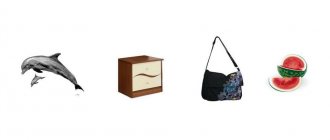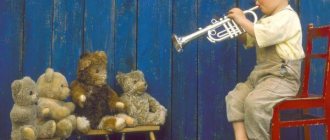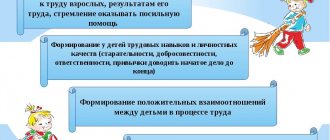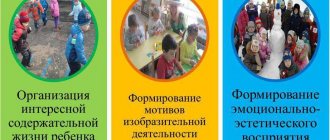Introducing works of art in kindergarten to middle preschool age
Introducing works of art in kindergarten
in middle preschool age
In the middle group, work to familiarize children with works of art continues, and I, following the recommendations of the authors of the comprehensive programs “Rainbow”, “Development”, “Education and Training in Kindergarten”, “Childhood”, solve the following tasks:
· Continue to examine objects of folk and decorative art.
· Introduce children to the profession of an artist.
· Develop the ability to identify genres and types of art: painting, sculpture, architecture.
· To consolidate children’s knowledge about books and book illustrations.
· Foster a caring attitude towards works of art.
In middle preschool age, children continue to become acquainted with works of fine art. Throughout the year, the children and I look at illustrations for children's books made by famous artists: Vasnetsov, Konashevich, Charushin, etc. Children get acquainted with small sculpture: bronze, porcelain, wooden images of animals and people with a pronounced character, plastic movement.
I choose material on fine arts, which is divided into sections: decorative arts, graphics, painting (still life, landscape, portrait, genre painting), sculpture, its types.
In September, October, November, I continue to introduce children to the depiction of floral patterns in the works of folk craftsmen and works of decorative and applied art, talk about the features of folk decorative and applied art, and organize an exhibition of works by folk craftsmen in the group.
In December, I talk about the profession of an artist.
In January, I continue to work on developing the perception of beautiful patterns and ornaments in works of folk and decorative art. I continue to introduce you to the profession of an artist.
In February, March and April I plan to look at the illustrations, talk about the work of illustrators, and organize an exhibition.
The authors of the comprehensive programs “Rainbow”, “Development”, “Education and Training in Kindergarten”, “Childhood” advise children to look at illustrations and reproductions of paintings - but do not indicate which artists specifically.
However, the Rostock program presents this material in particularly detail.
Thus, based on the recommendations of the authors of comprehensive programs, I collected and systematized material on introducing fine arts to the middle group.
In middle preschool age, I continue to introduce children to household objects, wooden toys (Bogorodsk carvings), objects made of carved birch (boxes, caskets), and creative objects (Vologda lace, knitting, embroidery).
When introducing the profession of an artist, I tell the children that artists are people who paint pictures, create illustrations for books, and make many surrounding objects beautiful. I show children various genres of painting - still life, portrait, landscape, fairy tale.
To introduce children to works of art, I most fully use the material from Shestakova’s “Rostock” partial program. Here work is carried out seasonally.
I continue to introduce children to sculpture, teach them to distinguish sculpture from painting, to learn the features of its content and some means of expression: volume, movement, the significance of the material from which the sculpture is made.
According to the author (“Program of education and training in kindergarten”), I introduce children to architecture, or rather, to the building of a school and kindergarten, a residential building with many floors, entrances, apartments, the building of circuses, theaters.
Acquaintance with works of art in our group is carried out on the basis of rich accumulated material.
Get text
Long-term work plan for introducing children to fine arts in the middle group
Transcript
1 Long-term work plan for introducing children to fine arts in the middle group Month Lesson section Topic Objectives September October Genres of painting 1 “The red summer has passed” 2 “Funny colors” Recall the colors of summer with the children (work on fixing well-known colors). Learn to see the entire image. Give children joy from what they see. Fixing known colors. Develop the ability to experience a landscape image and emotional perception of color. 3 “Landscape” Continue to get acquainted with the genre of landscape using the example of the works of I.I. Shishkina. Give concepts 4 “Walk through the summer garden” 5 “What the picture of autumn tells about” 6 “Autumn landscapes” “landscape”, “landscape artists”. Activate the experience of the landscape image. Feel the beauty of autumn in living nature. Feel the harmony of nature and art. Development of color vision and emotional perception of color. Feel the harmony of nature and art Teach a detailed examination of the motif of the image and understand it. To give an idea of the landscape as a picture reflecting the life of real nature. Bring children to understand the artist’s individual perception of real nature in the landscape. Fix the name of the “flowers” of golden and late autumn. Bring children to understand the artist’s individual perception of real nature in the landscape. 7 “Winter” Teach a detailed examination of the motif of the image and understanding it. Development of associative connections taking into account children's experience of observing nature.
2 November December January Sculpture Acquaintance with a portrait Meeting with cult painting 8 “Birds” Help determine the emotional state of images of birds (surprise, curiosity, conceit, etc.). 9 “Heroes” Continue to teach children to determine the emotional state of the image. 10 “Portrait” Give the initial concept of portrait as a genre of painting. 11 “Portrait” 12 “Movement in a Portrait” 13 “Icon” (Our Lady of Tenderness) 14 “Icon” (“Archangel Gabriel (Angel of Golden Vlas)”) 15 “Christmas Holiday” 16 “Ancient Russian Architecture” 17 “Excursion to the Summer Garden” 18 “Material and its properties” 19 “Sculpture and materials” Learn to look at a portrait. Form ideas about the content of the portrait (what the artist can talk about in the portrait). Teach children to see movement and character in a portrait. Compare children's life experiences with what they see in a work of art. Give first impressions of iconic painting. Give the concept of “icon”. Introduce icon painting techniques: wooden board and paints (tempera). Introduce the concepts: Mother of God, face, halo. Reinforce the concept of “icon”. Introduce the concepts: angel, archangel, icon painter. Tell children about Christmas. Introduce children to the plots of different icons. Give an idea of ancient Russian architecture. Introduce you to the churches of different cities (Novgorod, Moscow, Pskov), where you can see icons of ancient writing. Give an idea of sculpture as a form of fine art. Show the volume of the sculpture, the role of the spatial environment. Form the concept of “garden and park sculpture”. Introduce children to various materials, their qualities and properties. Development of tactile senses. Introduction to small sculpture. Development of tactile senses. To develop the ability to recognize various materials.
3 20 “Expressiveness and possibility of sculpture” Continue to teach to carefully examine, to see the characteristic features of sculpture (material, shape, volume, texture). February March Visiting the book 21 “Expressiveness and the possibility of sculpture” 22 “Book illustration” 23 “Book illustration” 24 “Acquaintance with V.G. Suteeva" 25 "Acquaintance with E.I. Charushin" 26 "Acquaintance with V.V. Lebedeva" 27 "Book illustration and artist" Continue to get acquainted with sculpture of small forms, paying attention to the volume of the sculpture. Memory development. Remember already familiar illustrators Yu.A. Vasnetsova, E.M. Racheva, K.V. Ovchinnikova. To deepen the understanding of book illustration and the expressive means used by the master (color, line, rhythm), with the help of which he creates an artistic image. Continue to develop the skill of looking at illustrations and correlating pictures with text. Consolidating knowledge about color and further developing the ability to distinguish colors. Teach to see the characteristics of the image of an animal in an illustration. Show by what means and how the artist conveys the characteristic features of the appearance of animals, their habits, mood, character (precisely found pose, expressiveness of movement, silhouette). Help children feel the artist’s individual style in illustration. Development of imagination. Learn to recognize and compare book illustrations by familiar artists, including illustrations by Yu.A. Vasnetsova, E.M. Racheva, K.V. Ovchinnikova. Continue learning to look at illustrations, matching the image with the text. Develop memory.
4 April May In the world of surrounding buildings Folk art 28 “City of Cheboksary” 29 “Lenin Avenue” 30 “Churches, cathedrals and temples of Cheboksary” 31 “Monuments of the city” 32 “Folk toys” 33 “Merry doll” 34 “Chuvash decorative and applied art » 35 “Chuvash clay products” Formation of generalized ideas about the native city, its history, originality of architecture, main attractions. Foster love for your city. To develop the ability to perceive architecture at the level of recognition and naming. Introduce the main street of the city and its name. Teach children to see the uniqueness of architectural structures. Introduce the main square of the Republic. Introduce the term church, temple, dome into the active dictionary. Acquaintance with the churches: Mother of God of Vladimir, St. Tatiana, Nicholas the Archangel, Holy Trinity Monastery, Vvedensky Cathedral. Learn to recognize and, if possible, name familiar architectural monuments of the city (monument to Yu.A. Gagarin, M. Gorky, V.I. Chapaev, etc.). Instill love for your city. To recall and consolidate children’s knowledge about Dymkovo, Filimonov and other toys already known to them from previous lessons. Introduce children to the Semenov matryoshka doll and Polkhov-Maidan toys. To give children the opportunity to see the originality of the Semyonovskaya and Polkhovo-Maidan nesting dolls. To give initial ideas and knowledge about the Chuvash arts and crafts. Develop emotional perception of color. Evoke associative images associated with flowers in Chuvash applied art. Introduce clay whistles to the favorite toys of Chuvash children. To cultivate a caring attitude towards beauty and respect for the creators of ChDPI works.
5
Lesson summary "Introduction to painting" for middle group children
Lesson summary “Introduction to painting”
(for middle group children)
Kovalskikh Margarita Vladimirovna
Kovalskikh Margarita Vladimirovna
Lesson summary “Introduction to painting”
for middle group children
Goal: Enriching children's ideas about fine arts.
Tasks:
- activate the vocabulary: joyful, cheerful, white and white, like a feather bed, slowly and smoothly, etc.
- continue to introduce the seasons, highlight their characteristic features
- continue to teach how to solve riddles,
-develop thinking and imagination
- develop the ability to see beauty in nature
Preliminary work: observing winter nature, reading poems, stories about winter, looking at illustrations and photos of snowflakes, drawing snowflakes, listening to music. Observing snow and studying its properties - sparkling, light as fluff, patterned, transparent, falling smoothly, slowly.
Equipment: painting “First Snow” by A. A. Plastov, music, white gouache, brushes, colored blue paper, water jars
Progress of the lesson
Educator:
— Guys, tell me, what time of year is it now? (winter)
- What happens in winter? (snow, frost, sleds, warm clothes)
- What kind of snow? (fluffy, soft, white, sparkling, cold)
—What can snow do in winter? (fly, fall, spin, melt)
— If snow falls for a long, long time, what do we call such a phenomenon? (snowfall)
Snowfall is a very beautiful natural phenomenon. You and I saw him on a walk yesterday. Today the sun is shining and we only have memories of snowfall. It is sad. But you and I will not be sad. I want to tell you about people who chose the profession of an artist.
— Do you know who artists are? (listen to the children's answers) That's right, children are the people who know how to draw. (I present to the children the painting “The First Snow” by Arkady Plastov and turn on the musical accompaniment). I give the children a few minutes to look at the picture.
Questions for children:
-Did you like this picture? (Yes)
-What exactly did you like? (girl, boy, crow, snowing)
-Would you like to hear a story about this picture? (Yes)
Story about the painting: This painting is called “First Snow”. It was written by the wonderful artist Arkady Plastov. The painting “First Snow” depicts a winter day when the first snow falls. Snow has already covered the ground, roof and porch of the house and continues to fall. There are two children standing on the porch - a boy and a girl. The children ran out onto the porch to look at the falling snow. The girl is standing in one light dress with a thin dark belt. She is wearing felt boots, but she is not wearing a fur coat. The girl will have a large light scarf on her head. We see the boy wearing a large sheepskin coat. The boy is wearing a dark hat with earflaps on his head. The girl looks up with delight at the falling snow, a satisfied smile is visible on her face. The boy also looks at the falling snow with interest, but without a smile. Near the porch of the house there is a tall birch tree and bushes. They are surrounded by a wooden fence and covered with a layer of snow. Not far from the porch, a crow walks through the snow. In the background of the picture you can see the neighboring wooden houses.








